Conducting Usability Testing and Gathering User Feedback: The Ultimate Guide
Get the latest updates about our blog posts.
Subscribe so you don’t miss out!
User experience (UX) in today’s fast-paced digital world, can make or break your product. No matter how innovative your idea is, poor usability can result in frustrated users and plummeting engagement. That’s why usability testing and gathering user feedback are essential components of any successful product development cycle.Key Takeaways
- Clear Objectives Are Crucial: Start with well-defined goals to guide your usability testing process and ensure relevant results.
- Choose the Right Testing Method: Whether it’s remote testing, A/B testing, or guerrilla testing, selecting the appropriate method is key to gathering meaningful insights.
- Recruit the Right Participants: Ensure your testers match your target audience for accurate and actionable feedback.
- Analyze and Synthesize Feedback Effectively: Combine qualitative and quantitative data to get a comprehensive understanding of usability issues.
- Iterate and Improve Continuously: Usability testing is an ongoing process—implement changes and test again to maintain a user-friendly experience.
Imagine launching a mobile app that your team has meticulously designed, only to find users abandoning it after just one interaction. The problem? They couldn’t figure out how to complete the most basic tasks. Situations like this are all too common—and entirely avoidable with proper usability testing.
In this blog, we’ll walk you through the fundamental steps to conduct usability testing, gather insightful feedback, and continuously improve your product.
What Is Usability Testing?
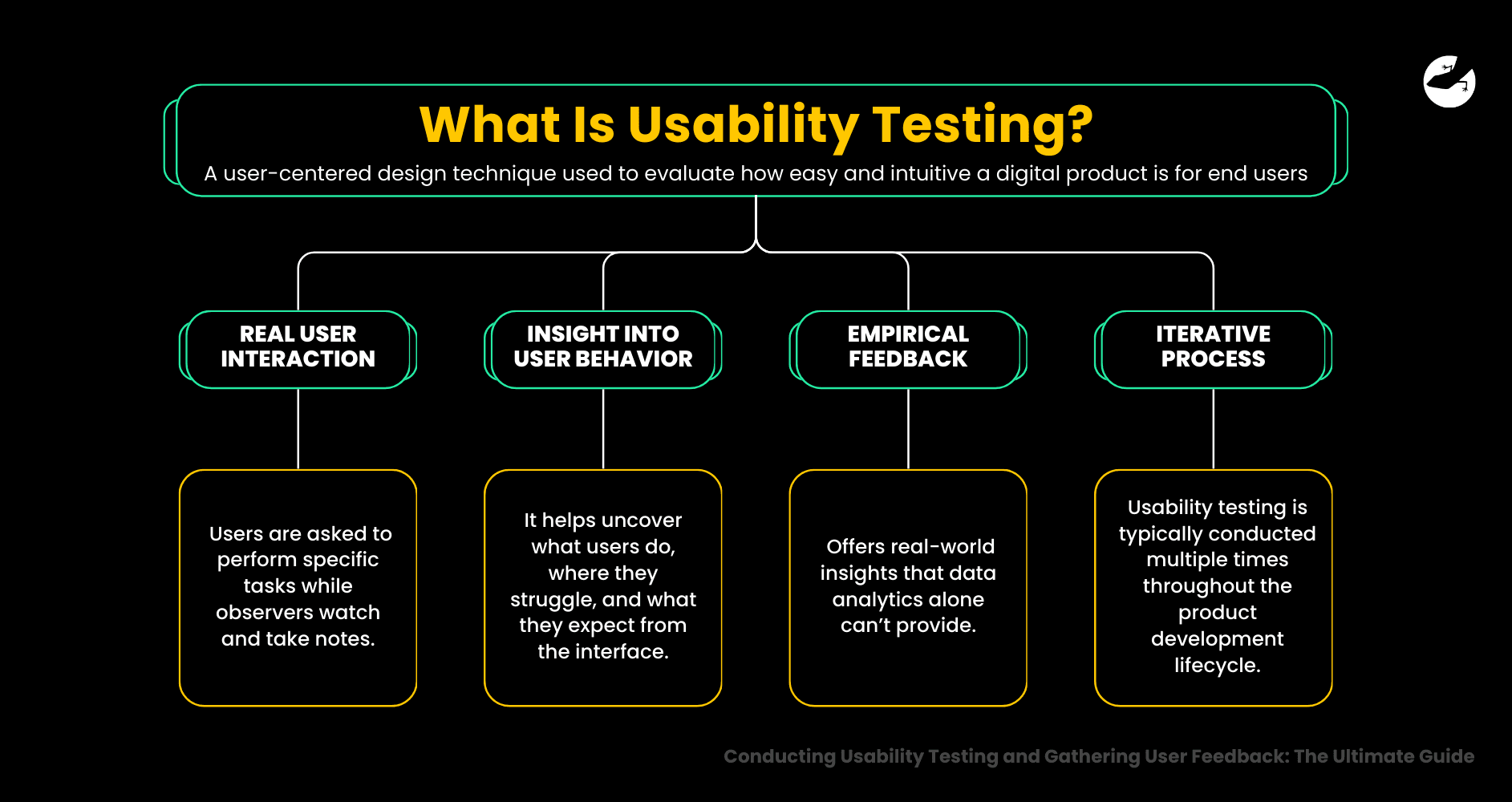
Before we dive in, it would be good to get a proper understanding on what usability testing is. Usability testing is a user-centered design technique used to evaluate how easy and intuitive a digital product is for end users. It involves observing real people as they attempt to complete tasks using your product—be it a website, mobile app, or software platform. The goal is to identify usability issues and areas for improvement early in the development process.
Key Points:
- Real User Interaction: Users are asked to perform specific tasks while observers watch and take notes.
- Insight into User Behavior: It helps uncover what users do, where they struggle, and what they expect from the interface.
- Empirical Feedback: Offers real-world insights that data analytics alone can’t provide.
- Iterative Process: Usability testing is typically conducted multiple times throughout the product development lifecycle.
Why Usability Testing Matters
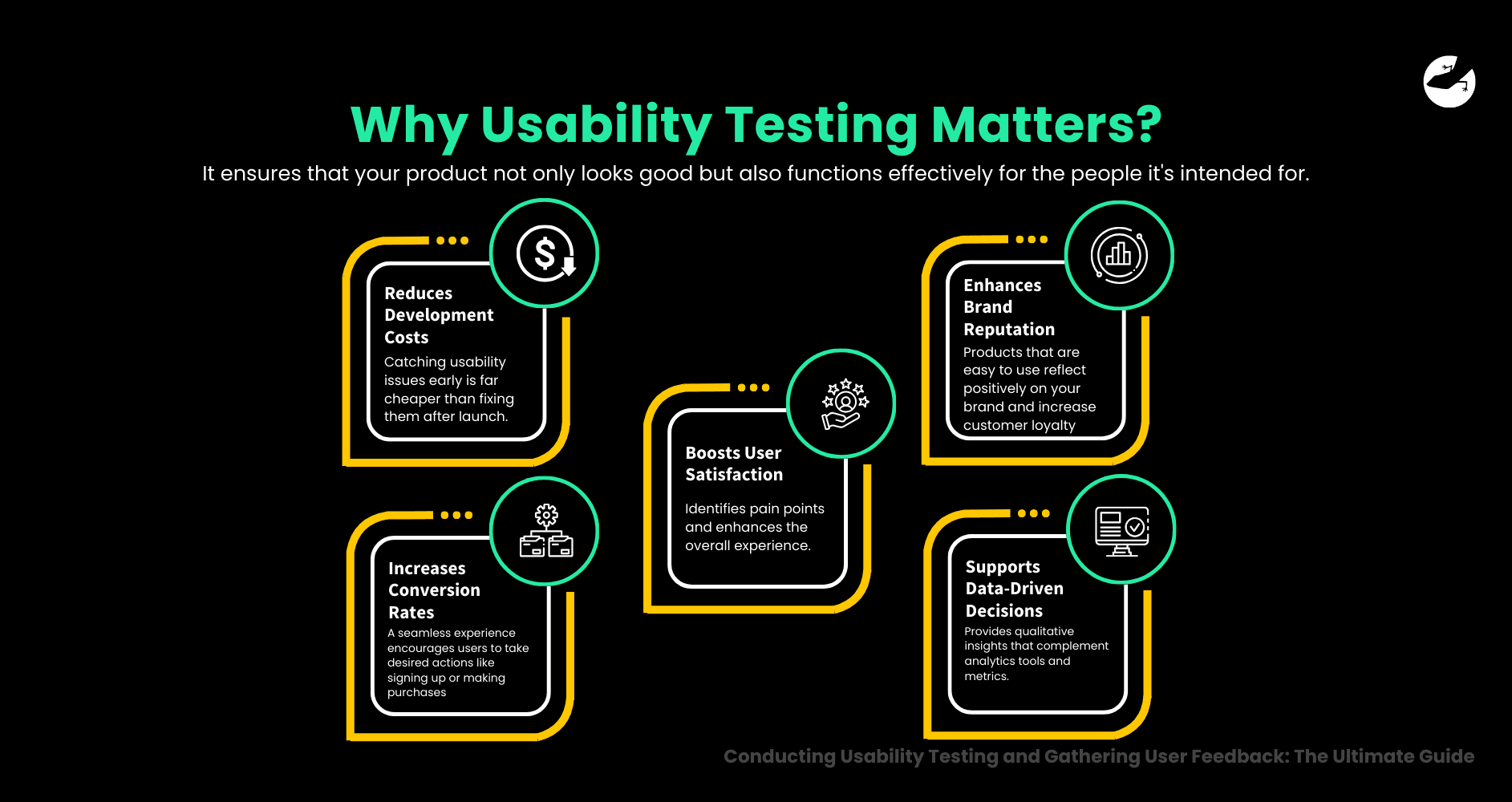
Even the most beautifully designed product can fail if users find it difficult to navigate or use. Usability testing ensures that your product not only looks good but also functions effectively for the people it's intended for. It bridges the gap between your development team’s assumptions and the actual user experience.
Key benefits of usability testing:
- Boosts User Satisfaction: Identifies pain points and enhances the overall experience.
- Reduces Development Costs: Catching usability issues early is far cheaper than fixing them after launch.
- Increases Conversion Rates: A seamless experience encourages users to take desired actions like signing up or making purchases.
- Enhances Brand Reputation: Products that are easy to use reflect positively on your brand and increase customer loyalty.
- Supports Data-Driven Decisions: Provides qualitative insights that complement analytics tools and metrics.
Steps To Conduct Usability Testing and Gather User Feedback
Conducting usability testing might sound complex, but it’s actually a straightforward process when broken down into actionable steps. Whether you're launching a new product or refining an existing one, these steps will guide you from planning your test to implementing user-driven improvements. Each step is crucial for understanding how users interact with your product and what can be done to optimize their experience.
Let’s walk through the process—from setting clear objectives to analyzing feedback and making impactful changes.
Step 1: Define Your Objectives
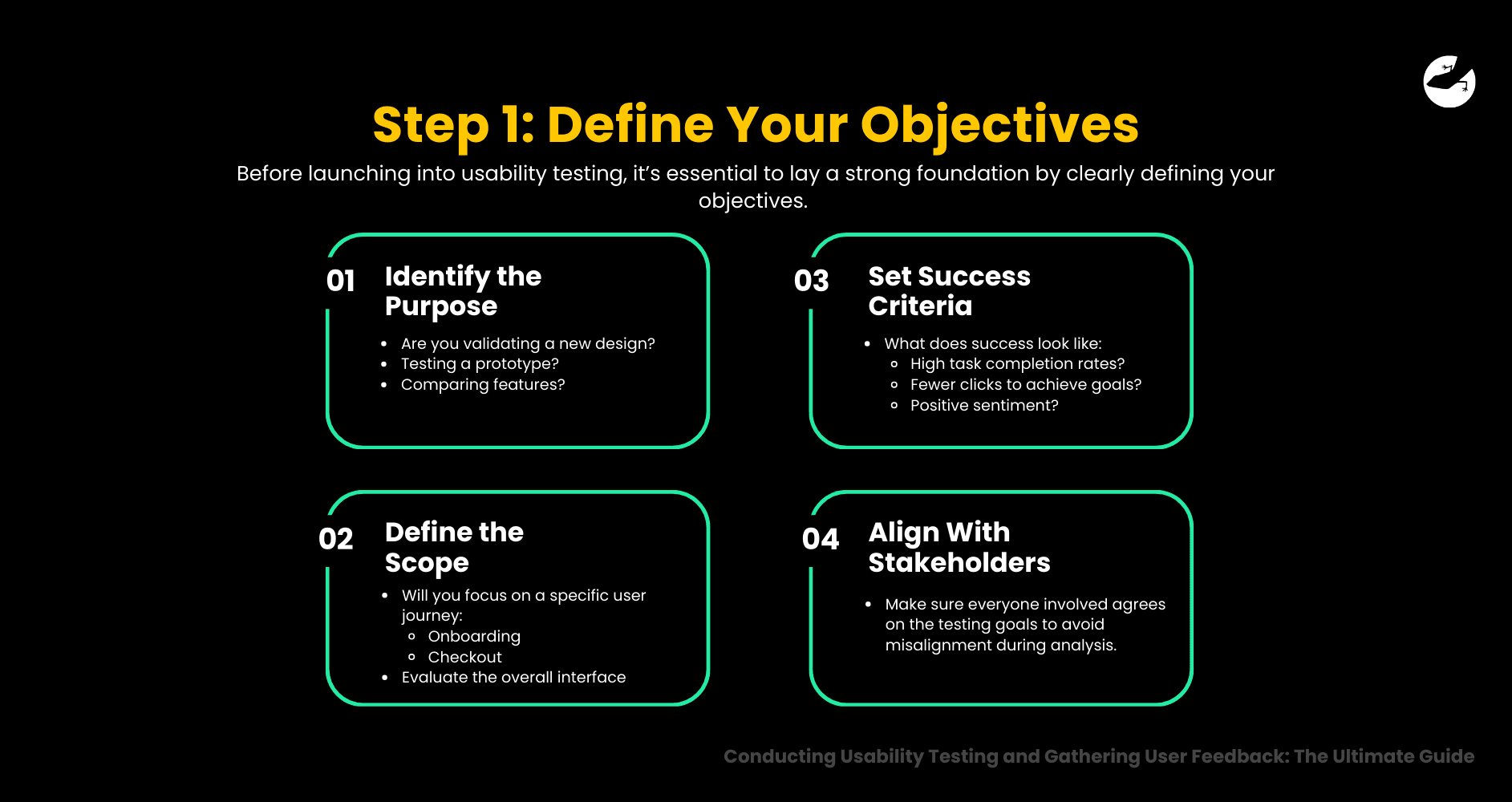
Before launching into usability testing, it’s essential to lay a strong foundation by clearly defining your objectives. Think of this step as setting the compass for your entire testing journey—without it, you risk collecting data that’s interesting but not actionable.
Your usability testing goals should be specific, measurable, and aligned with your broader product or business goals. Instead of just saying, “We want to improve the user experience,” dig deeper: What part of the experience? For which users? What behavior are you trying to influence or understand?
How to Set Strong Objectives:
- Identify the Purpose: Are you validating a new design? Testing a prototype? Comparing features?
- Define the Scope: Will you focus on a specific user journey (e.g., onboarding, checkout) or evaluate the overall interface?
- Set Success Criteria: What does success look like? High task completion rates? Fewer clicks to achieve goals? Positive sentiment?
- Align With Stakeholders: Make sure everyone involved agrees on the testing goals to avoid misalignment during analysis.
Example Scenario: Let’s say you're building a SaaS platform for project management aimed at remote teams.
A vague goal might be:
“See if users like the dashboard.”
A well-defined objective would be:
“Assess how easily first-time users can create a project, add team members, and assign tasks within their first 10 minutes using the platform.”
This objective gives you clarity on:
- Who to test (first-time users)
- What task to observe (project setup)
- How to measure success (time taken, task completion, user satisfaction)
Why This Matters: Clear objectives not only help you design better tests but also ensure that your team walks away with insights that directly inform design decisions. Without them, your findings can become too scattered to drive meaningful improvements.
Step 2: Choose Your Usability Testing Method
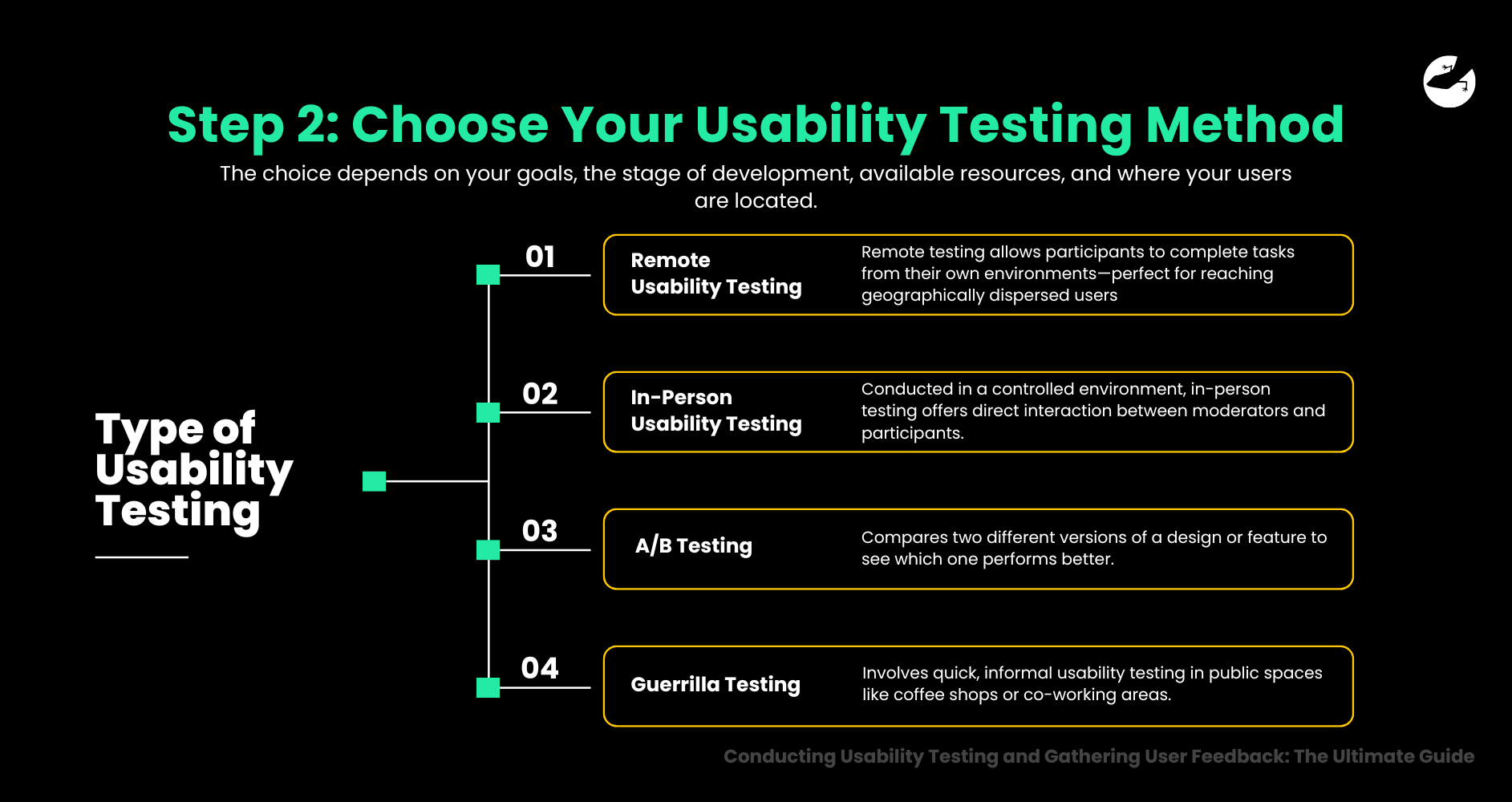
Selecting the right usability testing method is critical for collecting meaningful and actionable feedback. The choice depends on your goals, the stage of development, available resources, and where your users are located. Here’s a deeper look at the most common usability testing methods:
i. Remote Usability Testing
Remote testing allows participants to complete tasks from their own environments—perfect for reaching geographically dispersed users. Tools like Lookback, UserTesting, or Maze allow you to observe user behavior in real-time or via session recordings. This method is cost-effective and scalable, and it simulates how users would interact with your product in real-world conditions.
Best For: Broad audience reach, convenience, and cost-efficiency.
Keep in Mind: Ensure participants have the necessary tech setup and stable internet connections.
ii. In-Person Usability Testing
Conducted in a controlled environment, in-person testing offers direct interaction between moderators and participants. It enables real-time probing, body language observation, and immediate clarification of doubts. This method is especially effective for testing prototypes or products that require specific instructions or equipment.
Best For: High-fidelity testing and gathering rich qualitative insights.
Keep in Mind: It’s more resource-intensive and may require logistical coordination.
iii. A/B Testing
A/B testing compares two different versions of a design or feature to see which one performs better. For example, version A might feature a green CTA button while version B uses a red one. You then measure user behavior (clicks, conversions, engagement) to determine which version is more effective.
Best For: Testing specific UI elements or design variations.
Keep in Mind: It requires a significant sample size to produce reliable results.
iv. Guerrilla Testing
Guerrilla testing involves quick, informal usability testing in public spaces like coffee shops or coworking areas. You approach users, give them a brief overview, and ask them to perform simple tasks on your product. This method provides spontaneous, unbiased feedback—perfect for testing early concepts.
Best For: Rapid feedback on prototypes or MVPs.
Keep in Mind: Responses may be less detailed due to the informal nature.
Step 3: Recruit the Right Participants
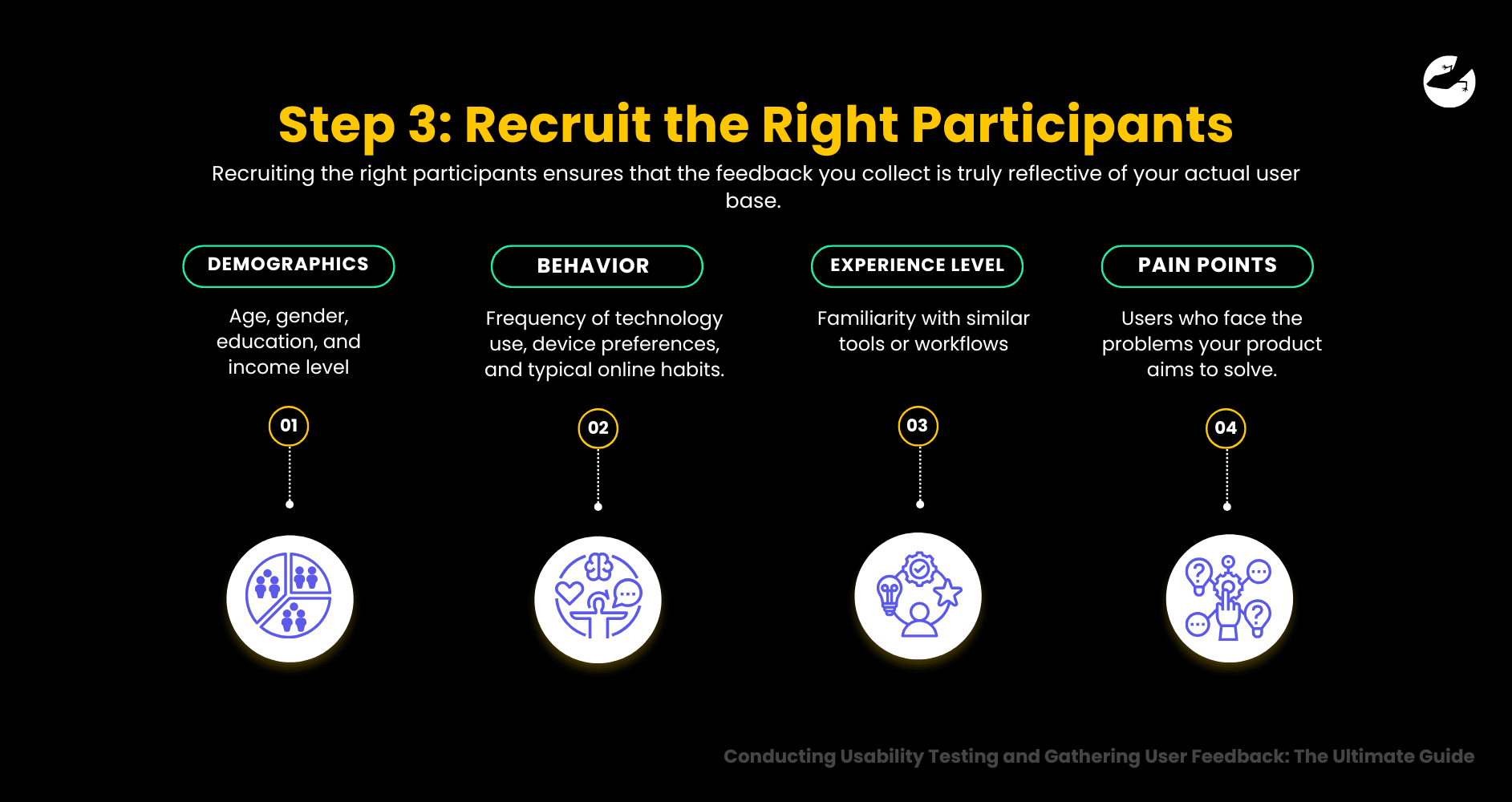
Usability testing is only as good as the users you test with. Recruiting the right participants ensures that the feedback you collect is truly reflective of your actual user base. The goal is to select users whose backgrounds, goals, and pain points align with those of your target audience.
How to Choose the Right Participants:
- Demographics: Age, gender, education, and income level.
- Behavior: Frequency of technology use, device preferences, and typical online habits.
- Experience Level: Familiarity with similar tools or workflows.
- Pain Points: Users who face the problems your product aims to solve.
Example: If you're testing a fitness tracking app, prioritize participants who:
- Regularly use fitness apps like Strava or MyFitnessPal
- Are health-conscious or have fitness goals
- Use wearables or track their workouts
Recruiting users like these ensures you gather relevant and meaningful feedback.
Step 4: Prepare the Testing Environment
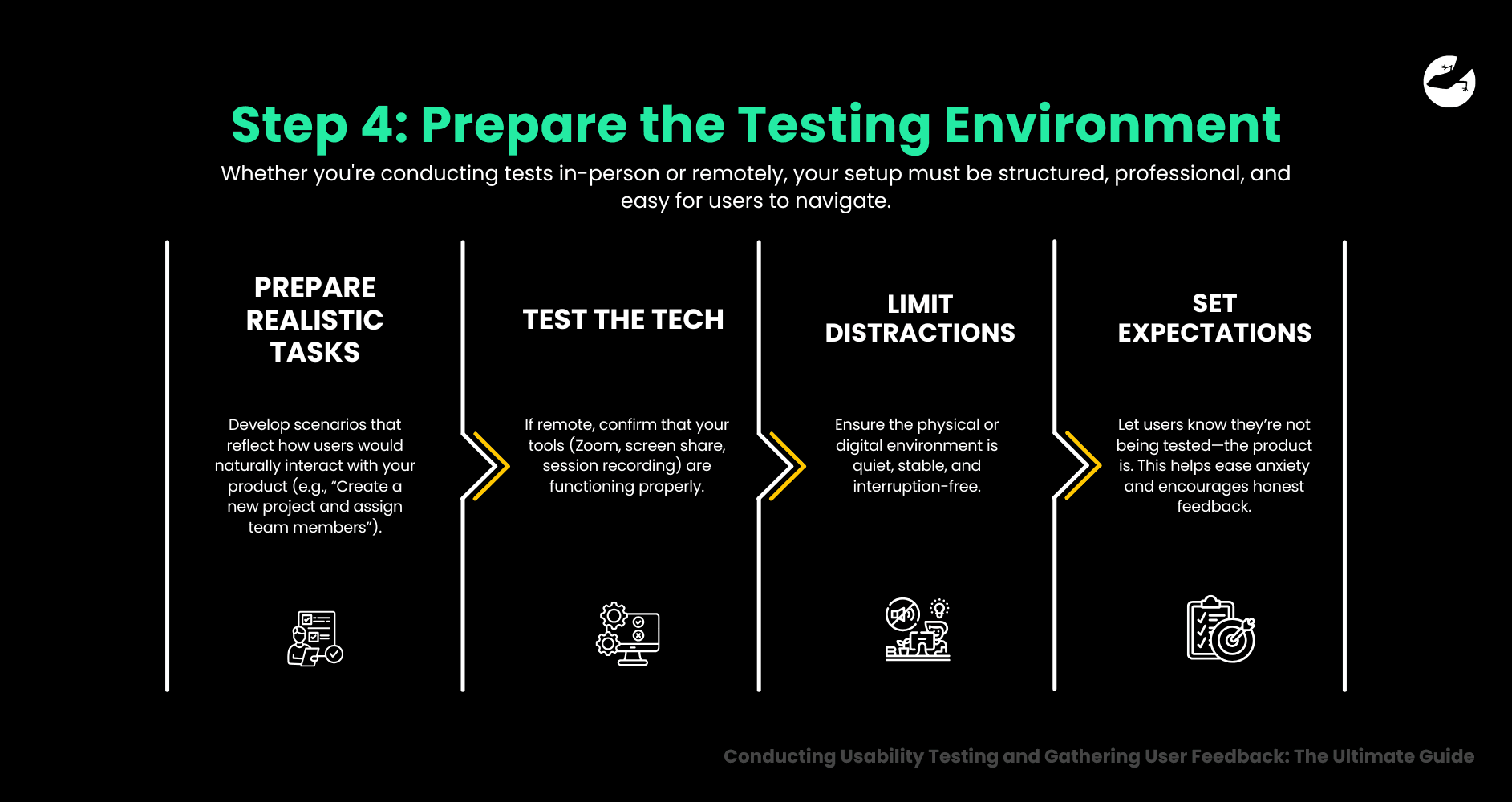
A distraction-free environment is crucial to capturing authentic and accurate results. Whether you're conducting tests in-person or remotely, your setup must be structured, professional, and easy for users to navigate.
How to Set Up for Success:
- Prepare Realistic Tasks: Develop scenarios that reflect how users would naturally interact with your product (e.g., “Create a new project and assign team members”).
- Test the Tech: If remote, confirm that your tools (Zoom, screen share, session recording) are functioning properly.
- Limit Distractions: Ensure the physical or digital environment is quiet, stable, and interruption-free.
- Set Expectations: Let users know they’re not being tested—the product is. This helps ease anxiety and encourages honest feedback.
Tips:
- Use screen recording tools to capture detailed interactions.
- Prepare a consistent script or task list to ensure standardization.
- Encourage users to speak their thoughts aloud as they complete tasks.
Want to find out how much it costs to build your dream app or web app?
Step 5: Conduct the Test and Record Observations
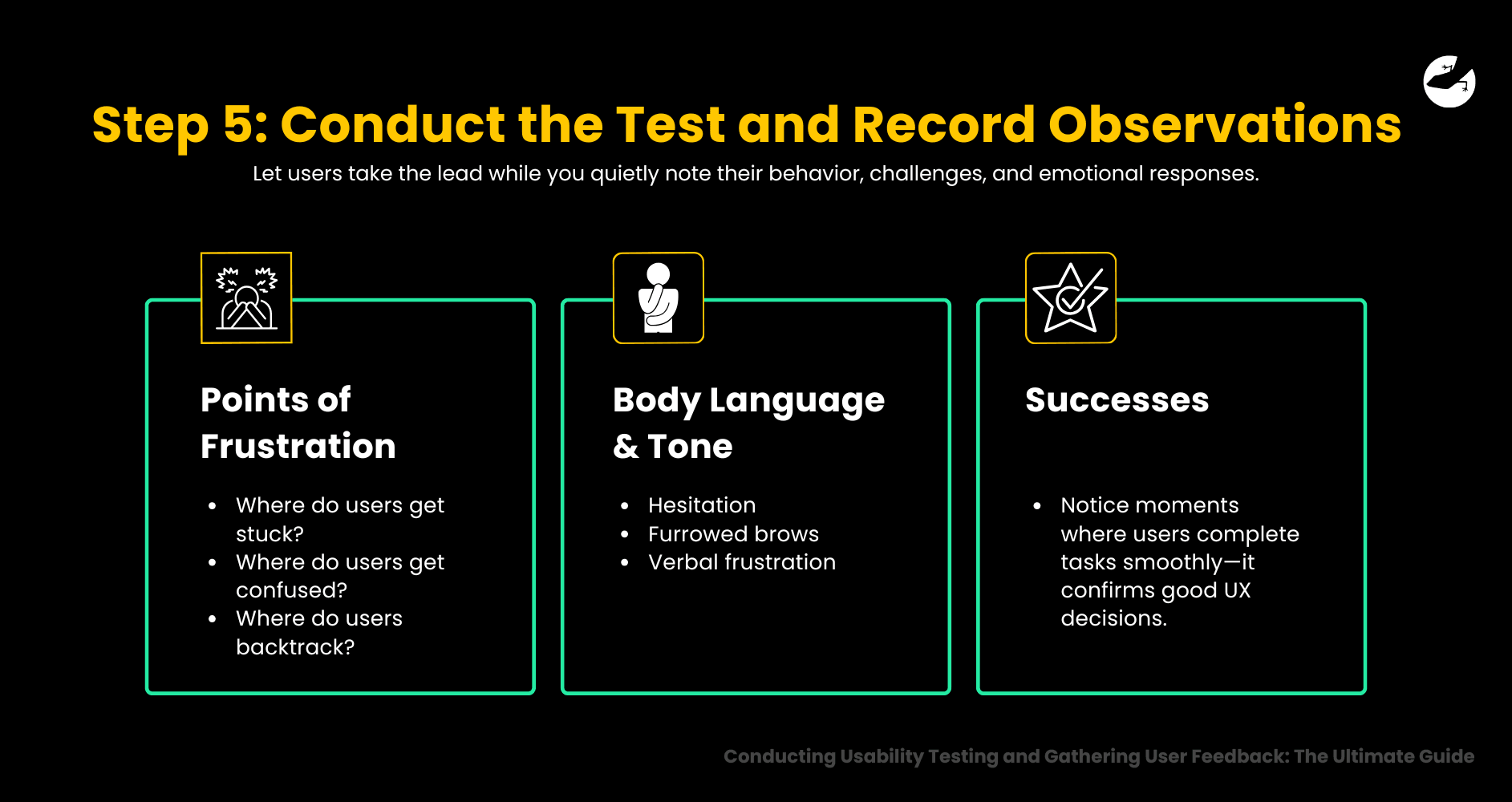
Once the test begins, your primary role is to observe, listen, and record. Let users take the lead while you quietly note their behavior, challenges, and emotional responses. This real-time feedback reveals usability issues that may not be obvious through data analytics alone.
What to Watch For:
- Points of Frustration: Where do users get stuck, confused, or backtrack?
- Body Language & Tone: Hesitation, furrowed brows, or verbal frustration may indicate pain points.
- Successes: Notice moments where users complete tasks smoothly—it confirms good UX decisions.
Encourage the “Think-Aloud” Protocol:
Ask participants to verbalize their thoughts as they navigate. Phrases like “I’m looking for…” or “I thought this would do…” are goldmines of insight.
Step 6: Analyze and Synthesize Feedback
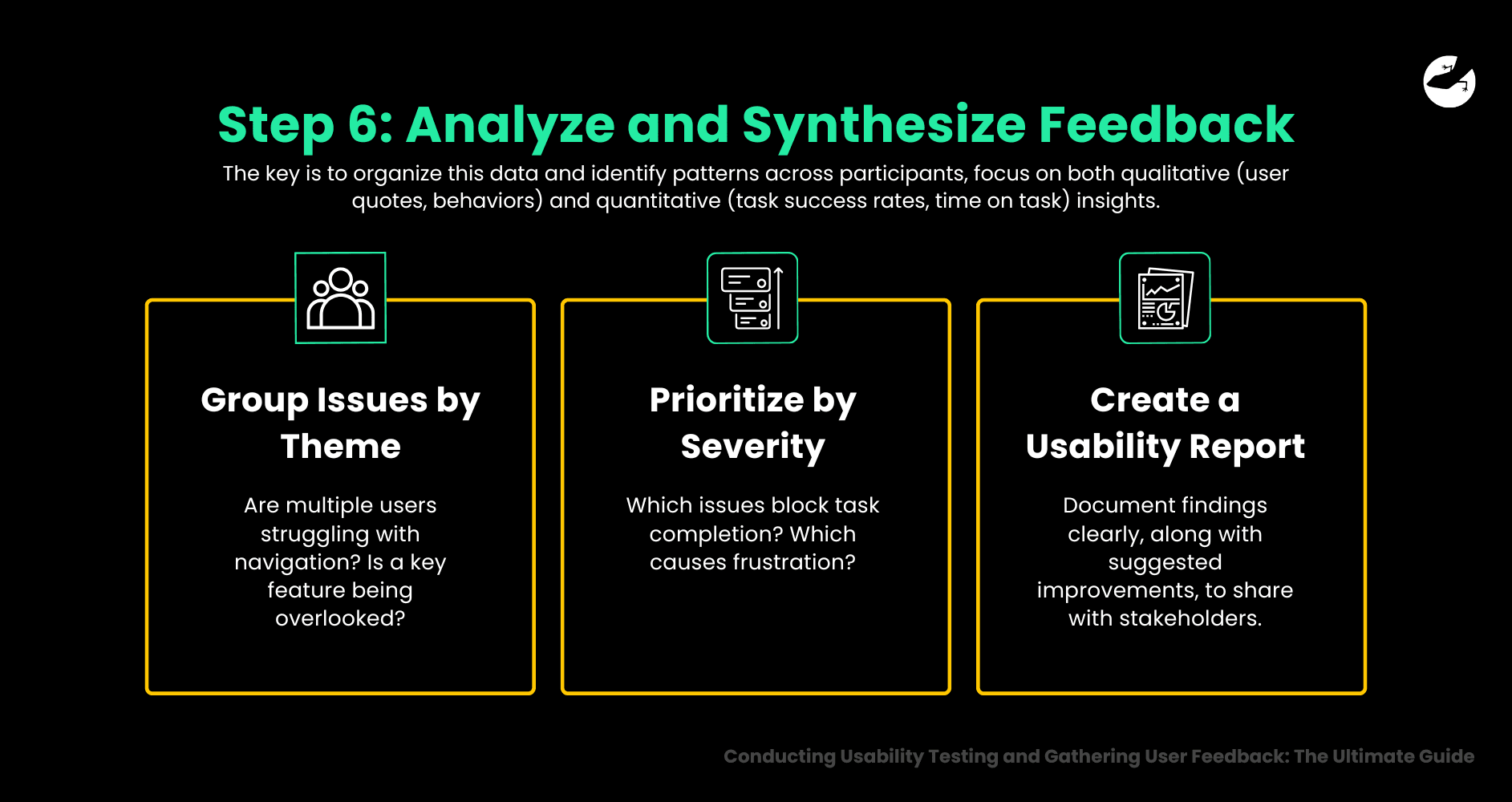
After testing, you’ll likely have a wealth of observations, notes, recordings, and possibly metrics. The key is to organize this data and identify patterns across participants. Focus on both qualitative (user quotes, behaviors) and quantitative (task success rates, time on task) insights.
How to Analyze Effectively:
- Group Issues by Theme: Are multiple users struggling with navigation? Is a key feature being overlooked?
- Prioritize by Severity: Which issues block task completion? Which causes frustration?
- Create a Usability Report: Document findings clearly, along with suggested improvements, to share with stakeholders.
Example:
If 4 out of 5 users couldn’t locate the “Create Task” button, this suggests a serious visibility or labeling issue that needs immediate attention.
Step 7: Implement Improvements and Test Again
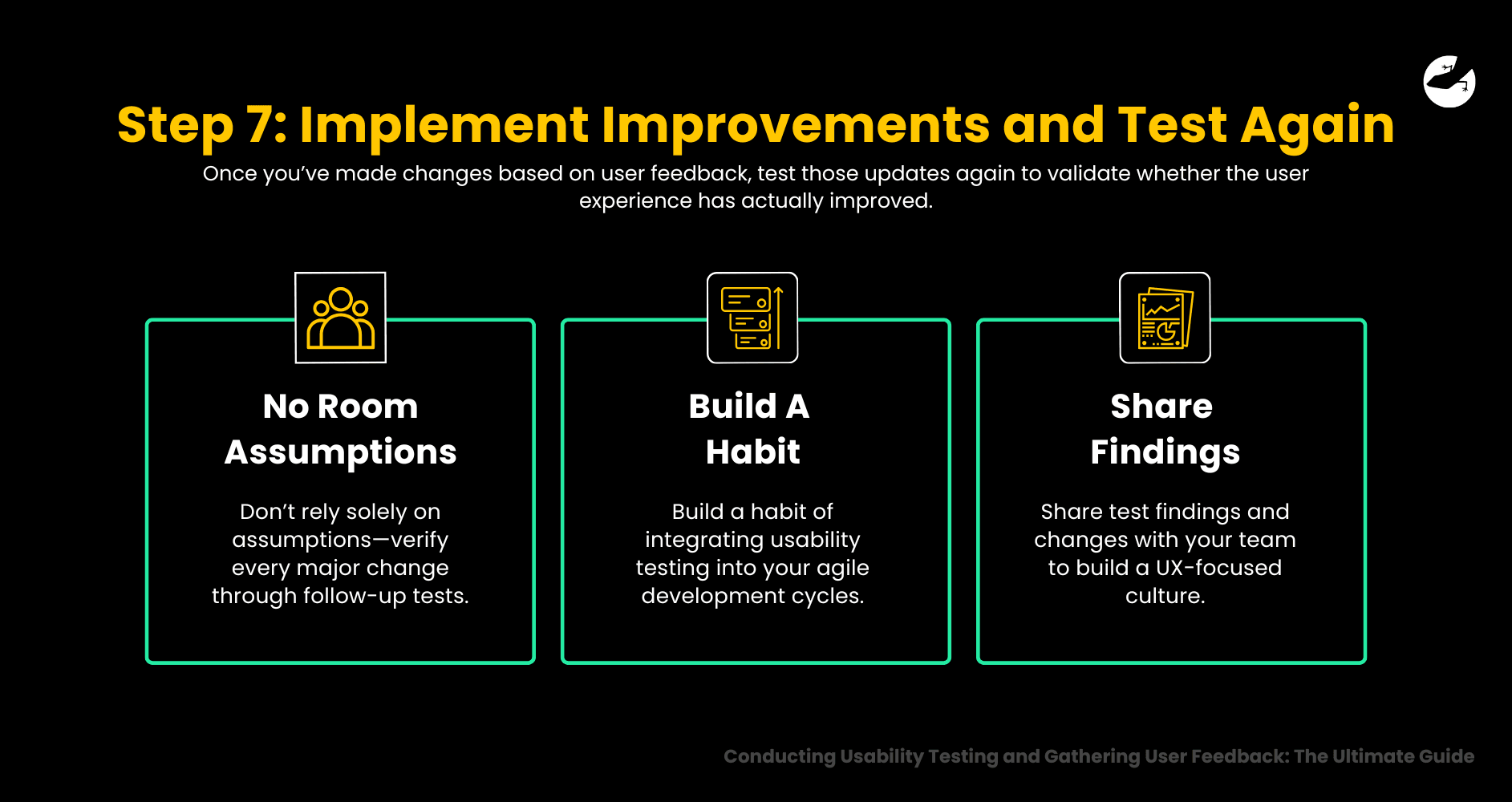
Usability testing is not a one-and-done activity—it’s part of a continuous improvement cycle. Once you’ve made changes based on user feedback, test those updates again to validate whether the user experience has actually improved.
Iterate With Confidence:
- Don’t rely solely on assumptions—verify every major change through follow-up tests.
- Build a habit of integrating usability testing into your agile development cycles.
- Share test findings and changes with your team to build a UX-focused culture.
Pro Tip:
Create a feedback loop. By constantly involving users in testing, iterating, and refining, you ensure that your product evolves in sync with user needs and expectations.
Let Lizard Global Enhance Your User Experience
At Lizard Global, we understand that seamless user experiences are the key to digital success. Our team of experts leverages proven usability testing methods and word of choice cutting-edge analytics to uncover critical insights. From recruiting the right participants to analyzing feedback and implementing improvements, we take care of the entire process, empowering you to create products that truly resonate with your audience.

Whether you need to validate a new feature or overhaul your entire UX, Lizard Global is here to help. Reach out to us today to elevate your digital solutions with data-driven usability insights!




